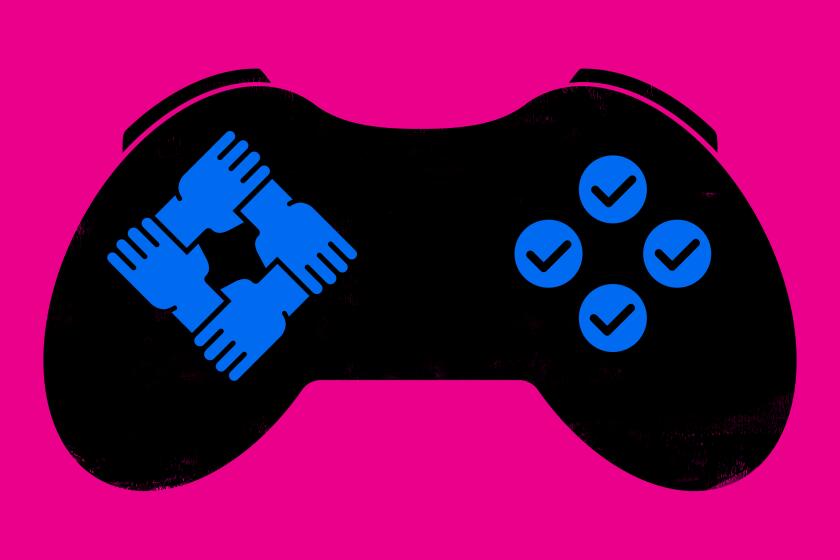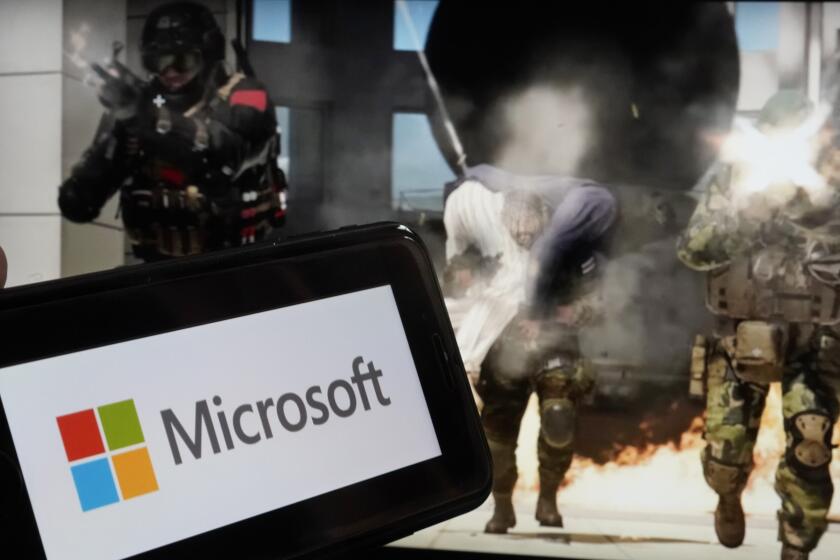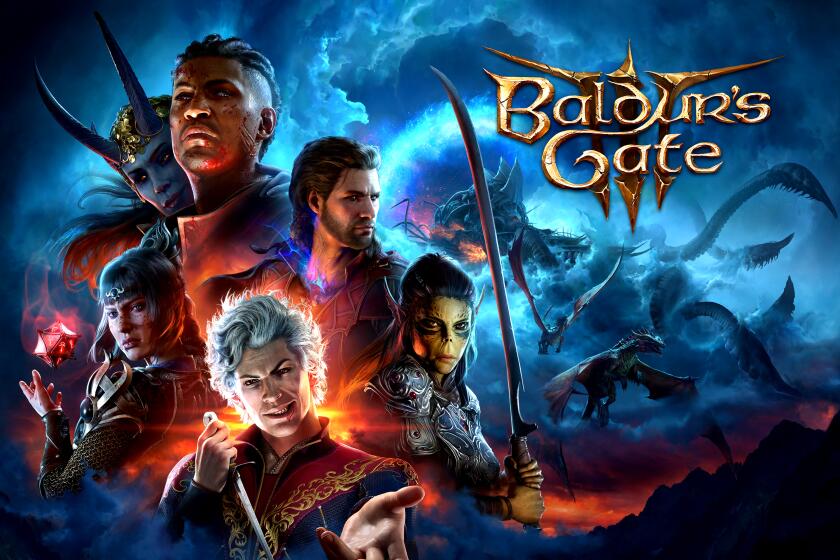Behind the making of newest ‘Call of Duty’ game: Getting the costumes right

- Share via
Tasha Valdez stood in front of a mannequin in a character scan room and tugged at the sleeves of the gray hoodie resting on its form.
Surrounded by racks of clothing and accessories, she prepped the look for scanning by a 3-D camera. Eventually, that jacket would find itself on a bad guy trying to blend into the background to hide his identity in the latest “Call of Duty” game.
Amid complaints about crunch times, claims of discrimination and calls for fair and transparent pay, more video game workers are seeking to unionize.
A senior associate scan technician at game developer Sledgehammer Games, Valdez has spent nearly 50 hours per week sourcing and scanning pieces of clothing for characters for “Call of Duty: Modern Warfare 3,” which released Friday.
The first-person shooter — Activision’s first big release since its acquistion by Microsoft — is the latest installment of the “Call of Duty” franchise that began 20 years ago. More than 3,000 people work on the franchise, which has sold more than 425 million units in that time while driving more than $30 billion in revenue, making “Call of Duty” the fourth-bestselling game franchise behind Mario, Tetris and Pokémon.
Last year, “Call of Duty: Modern Warfare 2” crossed $1 billion in worldwide sales in its first 10 days, according to Activision.
“Call of Duty” games are developed in around three years but the bulk of “Modern Warfare 3” was made in less than a year and a half, according to Bloomberg. A spokesperson for Activision declined to discuss production costs, but budgets for top franchises can exceed those of major movie productions with budgets surpassing $250 million.
.
As much as compelling stories and visceral settings are important, so too are authentic clothes for die-hard fans of the game’s narrative playthrough. The work that goes into creating looks for “Call of Duty” — be it military operative, bad guy or civilian — requires mapping out looks much like costume designers would for film or television.
Microsoft’s purchase of ‘Call of Duty’ maker Activision Blizzard marks the biggest deal in video game industry history.
The creative team working on the costumes consults military experts to ensure the outfits are accurate, in addition to other research. Valdez works closely with a lead character artist to create looks based off character concepts they receive.
Wrinkles and the general silhouette of a garment, she said, are key to helping character artists create an authentic look. When scanning clothes on the mannequin, she said, she makes sure to tuck clothing in a way that flows naturally.
“We want it to look as realistic as possible,” Valdez said.
Foster City, Calif.-based Sledgehammer took the lead on the development of “Modern Warfare 3,” while collaborating with other studios like Infinity Ward in Woodland Hills to ensure continuity across the franchise. Infinity Ward developed the game’s predecessor, “Call of Duty: Modern Warfare 2.” (Both Sledgehammer and Infinity Ward operate under Activision.)
The team at Sledgehammer works out of a digital gear library that Valdez fills with individuals items that can be pieced together for looks, from basic clothing to tactical jackets, bags and belts.
Online multiplayer is a gaming staple, but not every big title lets people play together at home. Games like ‘Baldur’s Gate 3’ and ‘Diablo 4’ are reinvigorating the genre.
Like a costume designer for a film production, Valdez sources items from vintage shops, in regular stores and online. A common item like the hoodie doesn’t take longer than a week to find, she said, while more unique items could take as many as three weeks to source. Valdez spends hours sifting through clothing racks and scrutinizes every detail, looking at the piece’s fit and interpreting what the item conveys about a character’s story.
The hoodie, for example, needed to be something lightweight that made the character’s appearance more subtle as he moved through a security checkpoint.
“I’ve cultivated a habit of proactively seeking out unique items, even before they are incorporated into a specific concept,” she said.
A military piece like a plate carrier vest — which would hold body armor plates — requires a little more work. The team can’t legally buy real ballistic plates, they said, so Valdez will pad a vest to make it look like real plates are inside. She would then scan the plate carrier itself and separately scan the pouches that could be placed on a vest so the pieces can be mixed and matched.
A team of five Sledgehammer developers work on the actual creation of a clothing asset, from concepting, scanning, modeling and creating the look in-game, to review. Each character’s look is determined by various factors, including the game’s story, gameplay, environment, animation and audio. As a result, a much larger team touches the product and brings each asset to completion.
But the process of creating costumes begins with allowing the game’s narrative to dictate the look, said David Swenson, campaign creative director for the game.
“Once we know who the character is, what they’re doing, what their job is going to be, what the context is for how they’re going to be in that moment, then that’s all the details that I arm Jon and his team with to be able to kick off and start creating that character,” he said, referring to the game’s content art director, Jon Riva.
When Riva has all the information he needs, he starts to create concept for a series of looks for Swenson. Usually, they sit down and hash out the details to ensure characters don’t all look the same and that characters’ signature looks — like Capt. John Price’s boonie hat — are recognizable.
Julia Bianco Schoeffling has just written a guide to acting for video games.
The key, Riva added, was keeping the looks true to form for a military operation. The team can’t take items off a shelf and place them into a game for legal reasons, he said.
“We have to make it believable, as close as real as we can without copying something else,” Riva said. “That’s very difficult to do.”
The game’s opening sequence, for example, shows an Alpha Team of operatives starting their clandestine mission underwater before scaling a prison from the sea. In the first part of the mission, the operatives don full scuba gear. But as they shoot their hooks and climb up the wall in the dead of night, much of that gear has been shed.
Well before the scene could make it to players’ screens, a question arose for the team: What would these operatives do when they were done with their scuba gear?
They turned to military experts, Swenson said, some of them former Navy SEALs who explained that they would strip their masks and scuba gear, fix their outfits underwater and emerge to continue their mission. There’s a moment in the game, he said, where the scuba gear comes off quickly as the team approaches the prison from the water. When the team is out, they’re not in the scuba gear anymore.
“They actually keep the wet suit on the whole time because it’s like, you don’t know if they’re gonna get back in or evac or any of these things,” Riva added. “We need that to be representative.”
Once a concept is finalized, character artist Lotem Sason will often use the library to build looks. Sometimes she will ask Valdez to scan a shirt she may need for a character; other times she reuses assets that already exist. When working on an outfit, she is responsible for things like shading and distressing.
“I’m making sure that this character can work in the game. I’m doing the modeling, the texturing,” she said. “I’m also building unique stuff. Some characters have a sci-fi look, so we have to model everything.”
Part of the design process also includes collaborating with other studios that have worked on different “Call of Duty” titles, like Infinity Ward.
Joel Emslie, studio art director at the developer company, helped to create the original set of characters players see in the newest game. For “Modern Warfare 3,” he took on a consultant role for the art directors at Sledgehammer while giving them the latitude to take characters to new places based on their story.
Emslie designed the iconic Ghost character in two hours in 2007, he said. The character shows up in multiple “Call of Duty” titles, including the newest game. So when it came time to outfit Ghost, the team consulted Emslie.
“It’s almost like the Dread Pirate Roberts from ‘The Princess Bride.’ Many people have played this role and characters evolve and look different,” he said. “I guess they were nervous because they knew how important it was to me. But they wanted to change Ghost’s mask a little bit. I’m like, ‘Yeah, why not? Go ahead. Have fun.’”
More to Read
Inside the business of entertainment
The Wide Shot brings you news, analysis and insights on everything from streaming wars to production — and what it all means for the future.
You may occasionally receive promotional content from the Los Angeles Times.














